If the heady early days of space exploration taught us anything, it was how much we just didn’t know. Failure after failure mounted, often dramatic and expensive and sometimes deadly. Launch vehicles exploded, satellites failed to deploy, or some widget decided to give up the ghost at a crucial time, blinding a multi-million dollar probe and ending a mission long before any useful science was done. For the United States, with a deadline to meet for manned missions to the moon, every failure in the late 1950s and early 1960s was valuable, though, at least to the extent that it taught them what not to do next time.
For the scientists planning unmanned missions, there was another, later deadline looming that presented a rare opportunity to expand our knowledge of the outer solar system, a strange and as yet unexplored wilderness with the potential to destroy anything humans could build and send there. Before investing billions in missions to take a Grand Tour of the outer planets, they needed more information. They needed to send out some Pioneers.
A Grand Tour on the Back of Orbital Mechanics
Even before the time of Kepler and Newton, the orbits of the planets had been well characterized, and astronomers were well aware that a planetary alignment would occur in the late 1970s that would allow a single spacecraft to visit each of the outer planets. After exploring Jupiter, the probe would use the gas giants’ gravity to fling it on to Saturn, then to Neptune, and then out of the Solar System. Such an alignment happens only once every 175 years, and it was too good to pass up.
But humanity hadn’t yet reached beyond the inner planets, and there were many questions. Would the asteroid belt prove an impenetrable barrier? Would Jupiter’s powerful radiation belts cook any probe that came close to it? And how would we communicate with a probe that far away? These questions and more presented unacceptable risks to a mission that would cost in the billions of dollars, and they needed to be answered before committing to a Grand Tour mission.
First proposed in 1964 as a “Galactic Jupiter Probes” and approved by NASA in 1969, what would come to be known as Pioneer 10 and Pioneer 11 would answer these questions. The idea was to build small, lightweight probes that would take advantage of favorable launch windows 13 months apart in 1972 and 1973. Each probe would carry just enough instrumentation to provide the data needed to plan the Grand Tour mission that would launch in 1977 as the Voyager program.
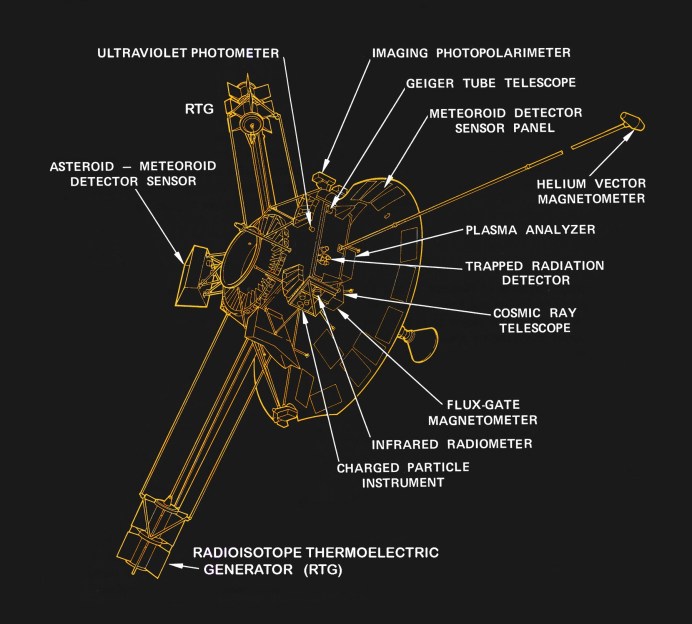
By space program standards, both the mission and the Pioneer spacecraft were full of hacks. Pioneer 10 would visit only Jupiter to get the critical data before heading off into deep space. Pioneer 11 would continue on to Saturn, assuming either probe survived the asteroid belt, where no probe had gone before.
The spaceframe for the probes was simple and lightweight, leveraging previous probes from the Pioneer program. It consisted of a dish antenna as large as the Atlas-Centaur launch vehicle, left over from the Mercury manned program, would allow. To reduce weight and cost, the Pioneer spacecraft would be spin-stabilized, reducing the amount of maneuvering fuel it had to carry. NASA lucked out on power for the probes, using radioisotope thermal generators (RTGs) that were given to the program by the Atomic Energy Commission. The devices only provided an energy budget of about 155 watts at launch, though, so instrumentation had to be carefully selected.
The limited energy budget meant NASA had to make some tradeoffs, though, and the biggest of these was to not include a computer onboard, at least not in the traditional sense. There was a tiny amount of memory on board, about 6-kB, which was just enough to store five commands uplinked from Earth. But everything the spacecraft would need to do would be commanded from the ground over the Deep Space Network (DSN), taking into account the 90 minute round trip when the machines were at Jupiter.
Pix or it Didn’t Happen
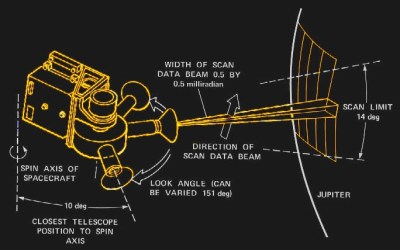
In the same way that we tend to take heat from social media friends if we don’t post pictures from a vacation, NASA was not going to get away with not sending back pictures from across the Solar System. But cameras and the gear needed to digitize, record, and transmit the data are bulky and energy-hungry, so mission planners had to be especially clever about a solution. They decided to take advantage of the spin-stabilization of Pioneer, using the 4.8 RPM rotation as a way to optically scan Jupiter as it approached the gas giant. The Imaging Photopolarimeter instrument was put to use as a one-pixel camera, sweeping off one scan for every rotation of the craft and changing the angle of the sensor slightly after each scan. Each scan was done twice, once with a red filter and once with blue, and the data was sent to the ground for extensive manipulation, including adding a false green channel.
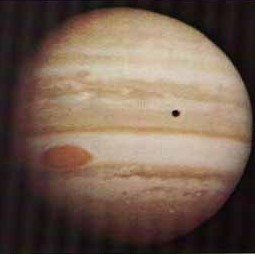
Despite the low-budget nature of the design, Pioneer managed to pack a lot of science on board, from cosmic ray detectors, to magnetometers, to the crucial micrometeoroid detectors used to analyze the risks of crossing the debris-strewn asteroid belt. That last instrument was a simple affair as well, with an array of cells pressurized with gas; any impact strong enough to burst a cell could be detected by the loss of pressure.
Pioneer 10 launched on March 2, 1972; Pioneer 11 followed 13 months later. After a 20-month journey, Pioneer 10, having survived what turned out to be the not-so-dangerous asteroid belt, arrived at Jupiter. It survived the onslaught of Jovian radiation, sending back data and pictures as it gained speed in Jupiter’s gravity well. The spacecraft performed flawlessly, flinging itself around the planet and providing humanity’s first look at a crescent outer planet as it achieved solar escape velocity and became the first interstellar spacecraft.
Aware of this fate, the Pioneer team had affixed the then-controversial but now-famous Pioneer Plaque to the spacecraft, bearing images of the spacecraft, figures representing the species that built it, and data to show where and when the craft was launched, in the unlikely event that it would ever be found by another spacefaring race.
Into the Void
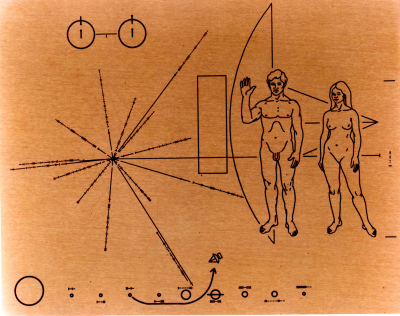
The Pioneer program was immensely successful, despite — or perhaps because of — its limited scope and budget. The Voyager probes, vastly more complicated and capable spacecraft, would be launched in 1977 and visit Jupiter, Saturn, Uranus, and Neptune with stunning images and torrents of data that scientists are still poring through, piecing together a picture of the outer Solar System before joining the Pioneers in interstellar space.
Both Pioneers long ago went silent, their RTGs finally having degraded to uselessness. Voyager still lives on, but what it accomplished was only because Pioneer paved the way.
Many thanks to [J.R. Dahlman] for the inspiration for this article, and the suggestion to read The Depths of Space: The Story of the Pioneer Planetary Probes by Mark Wolverton.

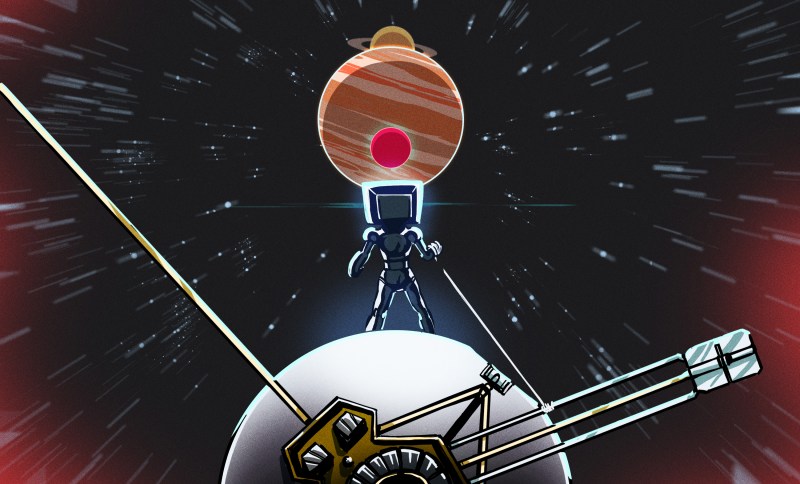















“But everything the spacecraft would need to do would be commanded from the ground over the Deep Space Network (DSN), taking into account the 90 minute round trip when the machines were at Jupiter.”
Sure beats SSHing in. :-)
“Aware of this fate, the Pioneer team had affixed the then-controversial but now-famous Pioneer Plaque to the spacecraft, bearing images of the spacecraft, figures representing the species that built it, and data to show where and when the craft was launched, in the unlikely event that it would ever be found by another spacefaring race.”
And V’Ger thanks you very much.
“…an energy budget of about 155 watts …”
Please… I thought Hackaday was the place the technically literate hang out.
That would be *power* budget. Watts are a measure of power, not energy.
Next thing you know we’ll be reading about it using 155 watts per hour, and we’ll think we are reading Popular Science.
Up your game, editors.
Somebody needs a hug today.
Ehmmm… technically this isn’t as bad as you might think. The nuclear batteries aren’t batteries as you have in your portable radio… (portable radios were all the rage in the 60’s and 70’s).
The nuclear generator generates a constant amount of electrical power of 155 watts (when it is new). You can use it or waste it, you decide, you can’t really save it for later. So you are really only able to consume a power of 155 watts, or less, but never much more. As the decay of the nuclear elements is constant, use it or waste it, storing it is not really an option due to the additional weight of the relatively low efficiency battery technology available at that moment and supercaps non existing. So technically speaking this is an energy budget. As at any given moment in time you MAY not use more then 155 watts. And considering that the system must operate for a long time, this budgets drops over time. So in short, you must prepare for the worst case situation from the start as much as possible to get the longest operational time.
Interesting technology.
Regarding the article, cool subject, all those missions at the dawn of technology are really interesting reading material. Please send us more!
*sigh* Seriously?
Errr… So power is no longer defined as energy at work? :-/
Energy…on the unemployment line. ;-)
Okay, that was a really good one. +100 lmao
Thank you for that fact-filled account of the Pioneer missions. However, I think you were way off in your second paragraph, saying “Even before the time of Kepler and Newton, the orbits of the planets had been well characterized, and astronomers were well aware that a planetary alignment would occur in the late 1970s that would allow a single spacecraft to visit each of the outer planets.”
Seriously? You think Gauss and Tycho were already imagining a grand tour? I doubt that very much. I forget the time or the person, but a TV show on the space program credited the idea to an engineer at JPL. I do know that several groups — academic and military — were looking at missions to Mars and Venus in the late 50’s. It was from these studies that the idea of a gravity assist first showed up. I wrote a survey paper on it ca. 1970, but I don’t think ANY astronomer was thinking in that direction much before 1960.
Maybe someone else here can fill in the gaps in my memory?
A reference to our Reptilian overlords. No cloaca in humans. Latin for sewer.
Camera was a single pixel scanning design, it appears. But light opening is larger than for the pinhole camera. Can someone elaborate why is that the case, in other words how do you select the opening (“pinhole”) size for such a system?
The number of pixels in a camera is entirely unrelated to the aperture size. Single pixel does not in any way imply it’s a pinhole aperture. It was a f/3.4 camera with a 2.54 cm aperture (i.e., a focal length of 8.6 cm). Its single pixel having a pixel size of 0.5 mrad. If you do the arithmetic, that comes out to a 43 micron sensor aperture size.
You select the aperture size by how much light you need on the sensor for a given exposure time and sensor sensitivity
Thank you. So it appears that some experimentation is ok to arrive at the proper functioning system.
The question has been bugging me. Pioneer 11’s end of mission was about 8 years sooner than Pioneer 10’s dispite being launched later.
From what I can tell the cause of Pioneer 10’s end of mission was a decline in RTG output sufficient to power the probes RF power amplifer (TWTA).
The cause of Pioneer 11’s end of mission seems more hazy. Some reference power output but that does not correlate with Pioneer 10’s RTG life. Others says it could not point its antenna to earth (low fuel? Other problem?)
Take a look at Oran Nicks “Far Travelers: The exploring machines”
https://www.amazon.com/gp/aw/d/B006IVYUUQ/ref=mp_s_a_1_3?ie=UTF8&qid=1527299427&sr=1-3&refinements=p_27%3AOran+W.+Nicks&pi=AC_SX236_SY340_QL65&dpPl=1&dpID=41mSTXksnHL&ref=plSrch
Especially chapter titled “Spinners last forever”
I can not remember which lucky bird it was, but the bird in question of the two, did indeed go silent fairly recently. Within the past twenty years that is. In fact they were still complaining when they left our solar system. And as far as I know neither have been used as target practice for passing spacecraft. By the way, I missed one of you at the VCF East last week…..